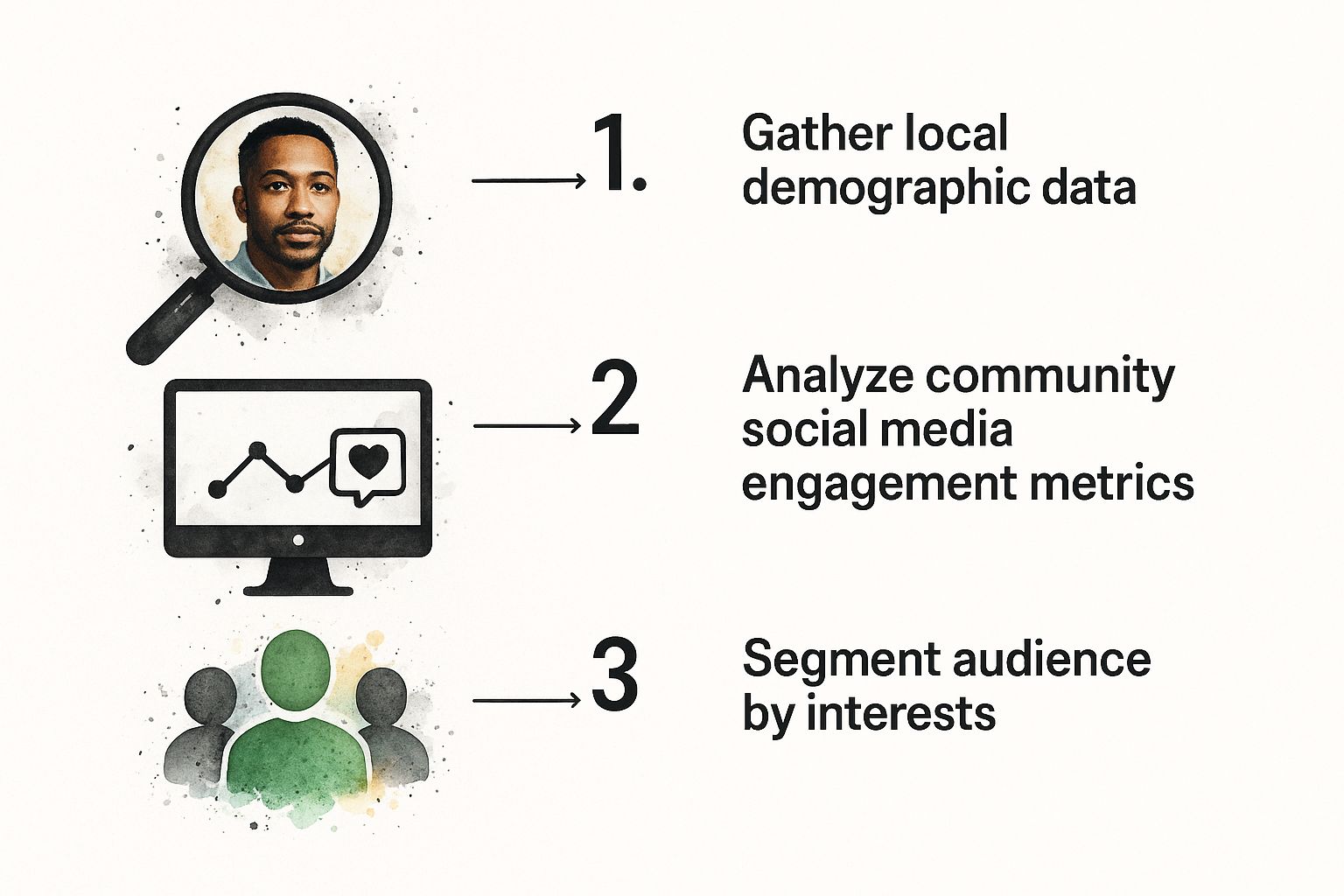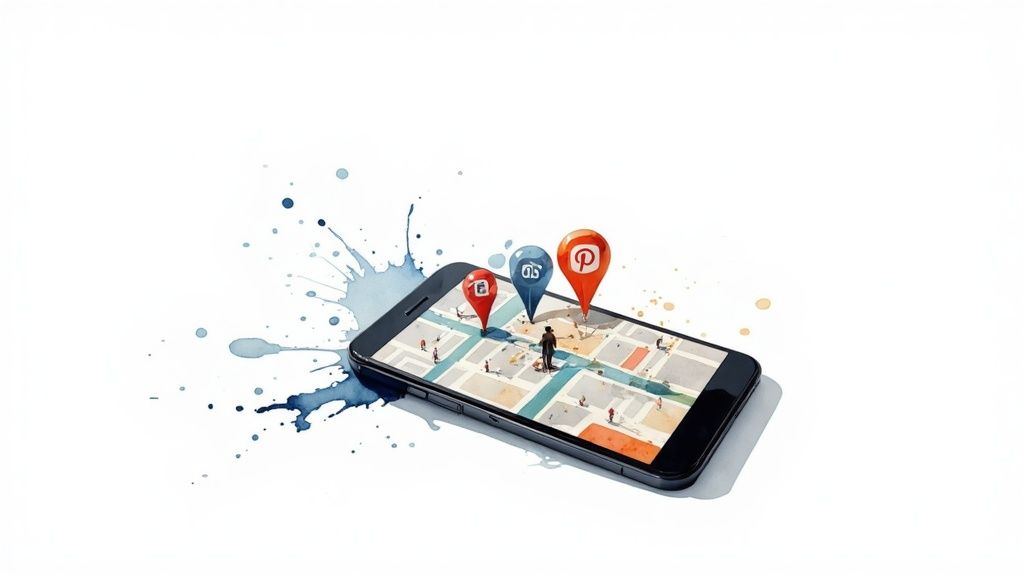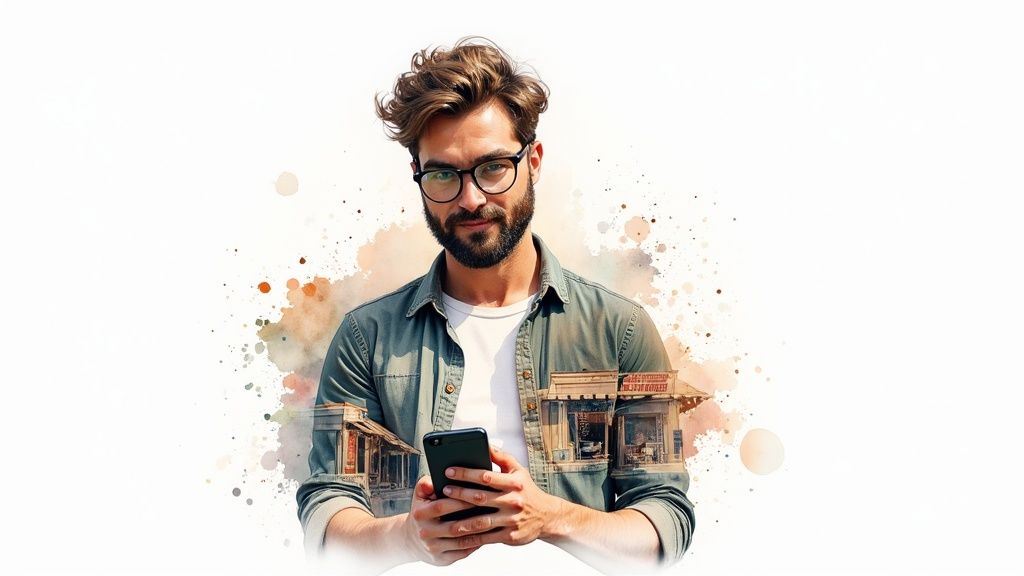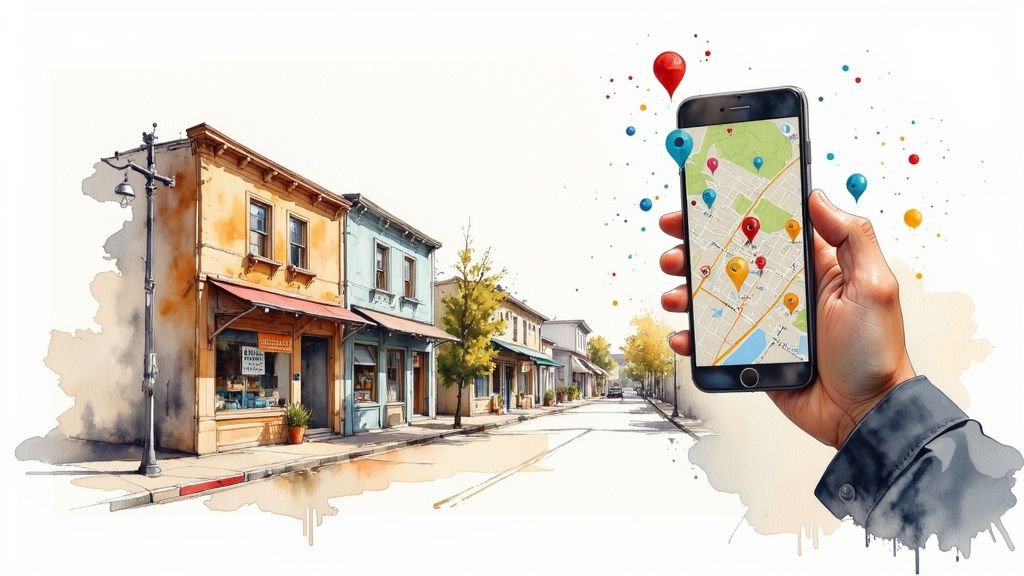Hyperlocal social media marketing is a laser-focused strategy. It’s all about reaching audiences in an incredibly specific geographic area—think a single neighborhood, a few city blocks, or even the immediate vicinity around your storefront. You're moving past broad, city-wide campaigns to connect with customers right where they live, work, and shop.
The goal? To stop being just another business and become a familiar, trusted part of the community fabric.
Why Thinking Small Delivers Big Results
Let's be honest, most broad social media campaigns feel impersonal. They're like a billboard on a busy highway—plenty of people see it, but it doesn't really speak to anyone in particular. Hyperlocal marketing completely flips that on its head.
Instead of shouting into a digital void, you're starting real conversations in the neighborhood's online town square. This isn't just about tweaking your ad radius; it’s about strategically weaving your brand into the daily rhythm of a community.
Building Genuine Trust and Credibility
When a local coffee shop posts about the Saturday farmers market down the street, or a boutique promotes a fundraiser for the nearby high school, they're doing more than just selling. They're showing they're part of the same community. They're a neighbor.
This builds a level of trust and authenticity that generic, one-size-fits-all marketing just can't touch. Customers start to see you as one of them, not just another corporate logo trying to get their money. This is huge, especially since more and more consumers are actively trying to support local businesses. A hyperlocal strategy plugs you directly into that sentiment.
The real magic of hyperlocal marketing is that it shifts your business from a place people buy from to a partner they believe in. That's how you create a fiercely loyal customer base that not only comes back but tells their friends about you, too.
Driving Real-World Foot Traffic
For any brick-and-mortar business, the ultimate goal is getting people to walk through the door. This is where hyperlocal marketing truly shines. It bridges the gap between online chatter and offline sales by targeting people based on their physical proximity and immediate needs.
Imagine a restaurant running a targeted ad for a lunch special. That ad can pop up on the phone of someone just a few blocks away, right as they're wondering where to eat. It's a direct, timely, and incredibly relevant nudge that turns a social media scroll into a sale.
Hyperlocal vs. General Social Media At a Glance
To really get why this approach works so well for local businesses, it helps to see the strategies side-by-side. The differences in targeting, content, and goals are pretty stark.
Here’s a quick breakdown of how hyperlocal marketing compares to a more traditional, general social media approach.
Hyperlocal vs. General Social Media At a Glance
| Aspect | General Social Media Marketing | Hyperlocal Social Media Marketing |
|---|---|---|
| Audience | Broad demographics (e.g., age, interests) across a wide region. | Highly specific geographic area (e.g., zip code, 1-mile radius). |
| Content | General brand messaging, promotions, and industry topics. | Community-focused content, local events, and neighborhood news. |
| Goal | Increase brand awareness and online engagement. | Drive foot traffic, build local loyalty, and increase in-store sales. |
| Tone | Corporate and polished. | Conversational, neighborly, and authentic. |
As you can see, it's a fundamental shift in mindset. General social media is about casting a wide net, while hyperlocal is about becoming the go-to spot in your own backyard.
Building Your Hyperlocal Digital Storefront
Before you can win over the neighborhood, people need a way to find you online. The best way to think about your social media profiles and business listings is as your digital storefront. They need to be just as inviting, accurate, and easy to find as your physical location. Honestly, any effective hyperlocal social media marketing has to start with a rock-solid online foundation.
Your digital presence must be perfectly set up for local discovery. This is about more than just having a profile; it's about actively using the specific tools on each platform to anchor your business right in the community. When someone pulls out their phone for a "near me" search, your business should be the most obvious, compelling choice.
Master Your Google Business Profile
If there's one piece of your hyperlocal puzzle to obsess over, it's your Google Business Profile (GBP). It's often the very first interaction a potential customer has with your brand. Just claiming it isn't enough—you need to treat it like an active, dynamic marketing channel.
Make sure every single field is filled out, and I mean every field. This includes your business name, address, and phone number (NAP), which must be 100% consistent everywhere online. Any little discrepancy can confuse search engines and tank your local ranking.
But don't stop at the basics. Dig into all the features Google gives you:
- Services/Products: Get specific. A local bakery shouldn't just list "baked goods." They should detail "custom cakes," "sourdough bread," and "gluten-free pastries." This is what people are actually searching for.
- Q&A Section: Don't wait for people to ask. Proactively add the common questions your customers have and answer them yourself. This gives people quick info and helps you show up for those exact questions in search results.
- Google Posts: Get in the habit of regularly sharing updates, special offers, and event announcements directly on your profile. These posts don't last forever, so consistent activity is a strong signal to Google that your business is active and relevant.
The whole process of figuring out and targeting your local audience is what makes or breaks a campaign. This graphic really breaks down how to think about it methodically.

As you can see, it all flows from understanding your community’s habits and demographics. That's how you create audience segments that actually connect.
Anchor Your Brand with Location-Based Features
Once your GBP is in top shape, turn that same attention to your social media platforms. They have some incredibly powerful tools to ground your content in a specific place, making you way more discoverable to people nearby.
Take Instagram's location tags, for example. These are completely non-negotiable for hyperlocal content. When you tag your physical address in a post or Story, your content gets added to that location's public feed. Someone just browsing posts from your neighborhood could stumble upon your daily special, creating an instant connection.
Pro Tip: Don’t just tag your own business. Tag surrounding landmarks, popular parks, or even neighboring businesses (the non-competitive ones, of course). This broadens your reach across the community’s digital map.
Facebook's check-in feature works in a similar way, basically turning your customers into brand advocates. Try offering a small incentive, like a 10% discount, to encourage visitors to check in. Every time someone does, they broadcast your business to their entire network. That's authentic, word-of-mouth marketing that is absolutely priceless for building local credibility and driving real foot traffic.
Creating Content That Speaks the Local Language

Let's be blunt: generic content is the fastest way to get scrolled past. If you want your hyperlocal social media to actually work, your brand needs to sound less like a faceless corporation and more like a friendly neighbor who knows the area inside and out.
This means you have to move beyond just posting about your latest sale. It’s all about plugging into the community's unique vibe and creating content that genuinely reflects the local culture. This is how you stop being just another marketing channel and start being a real hub for community life.
The goal is to prove you're an active participant in the neighborhood, not just a business that happens to be located in it. When your posts hit home on a personal level, you forge a connection that broad, impersonal campaigns can only dream of.
Weave Your Brand into the Community Fabric
To speak the local language, you have to be part of the local conversation. This isn't complicated—it just means paying attention to what the people around you care about and finding authentic ways to join in.
Let’s say you run a coffee shop. Generic content is posting a picture of a latte with the caption, "Happy Friday!" Yawn.
But what if you posted a picture of that same latte, this time in a cup sleeve that says, "Good luck to the Northwood High Panthers in tonight's game!" See the difference? That small shift changes everything. You’re no longer just selling coffee; you’re part of a community event, showing support, and connecting with local pride.
The real magic happens when your content feels like an inside joke that only locals would get. When you reference a quirky landmark, a beloved annual festival, or even the notorious pothole on Main Street, you signal that you're one of them.
Practical Ways to Create Localized Content
Getting started is probably easier than you think. It's really just about observing what’s happening right outside your door and turning it into engaging social media posts.
Here are a few ideas to get you going:
- Celebrate Local Happenings: Build content around high school sports, the weekend farmers' market, town parades, or local charity drives. This shows you're invested in what actually matters to residents.
- Reference Beloved Landmarks: Snap a photo of your product with a well-known local mural or statue in the background. Then, ask your followers to share their favorite memories of that spot.
- Highlight "A Day in the Life": Showcase the daily rhythm of your neighborhood. This could be a shot of the morning commuter rush on a specific street or the quiet afternoon at a beloved local park.
For example, a clothing boutique could put together a style guide on "What to Wear to the Downtown Art Walk," featuring their own apparel. This is both promotional and genuinely helpful for the community. If you need more inspiration for building out a solid content plan, you can check out the ideas on the Rebel Growth blog.
Partner with Other Local Businesses
One of the most powerful—and often overlooked—hyperlocal strategies is simply teaming up. Cross-promotion with other non-competing businesses in your area creates a network effect where everyone wins.
Think about collaborations like these:
- Joint Giveaways: A local bookstore and a nearby café could partner up for an Instagram giveaway for a "book and a coffee" prize package. Simple, but effective.
- Event Co-Hosting: A yoga studio and a health food store could co-host a free wellness workshop, pulling in both of their audiences.
- Mutual Shout-Outs: Sometimes, it's as easy as featuring another local business you admire in your posts. They'll likely return the favor, exposing you to their followers.
This approach not only strengthens community bonds but also introduces your brand to a new, highly relevant audience. An analysis of hyperlocal marketing campaigns confirmed that this type of tailored content generates significantly higher social media interaction compared to broader campaigns, which is a massive boost for trust and credibility.
Actively Engaging Your Neighborhood Online

Look, putting out great local content is a fantastic start. But if you want your hyperlocal social media to actually work, you have to do more than just post and wait. That's a passive approach. To really become a fixture in your community's digital life, you need to shift from being a broadcaster to being an active participant in the conversation.
This means you’ve got to get in there. Seek out discussions, respond thoughtfully to comments, and make your brand a helpful, present voice online. It’s about building real relationships, not just chasing vanity metrics like impressions.
Tap into Real-Time Community Conversations
Platforms like X (formerly Twitter) are absolute goldmines for real-time hyperlocal engagement. The fast-paced nature of X is perfect for keeping a finger on the pulse of what’s happening in your neighborhood right now. A great starting point is to set up saved searches or lists to track local hashtags—think #DowntownLive or #CityFarmersMarket—and mentions of nearby landmarks or events.
When you see a relevant conversation pop up, jump in. If people are buzzing about the weekend’s street fair, add a helpful tip or share your own excitement. Someone asking for a lunch recommendation near your shop? Go ahead and respond genuinely, even if it means suggesting another great local spot. This kind of interaction positions you as a helpful neighbor, not just another business trying to make a sale.
Different platforms offer unique ways to do this. X's real-time feed is great for monitoring trends with hashtags and location tags. On the B2B side, LinkedIn provides a space to connect with local professionals through groups and events. You can find more practical ideas for connecting with your community on newpathdigital.com.
Spark Engagement with User-Generated Content
Let's be honest, one of the most powerful forms of social proof is user-generated content (UGC). It’s authentic, it builds trust, and it shows that real people in your community genuinely love what you do. You just need to give them a little nudge to create it.
A simple photo contest is a classic for a reason. Imagine a local ice cream shop running a contest asking customers to post a picture of their favorite flavor with a unique hashtag like #ScoopsOfSummer. The prize doesn't have to be extravagant—a free cone or a feature on your social media page often does the trick.
By encouraging UGC, you're not just getting free marketing material; you're building a community of brand advocates who feel personally connected to your success. It transforms customers into active participants in your story.
Collaborate with Local Micro-Influencers
Forget about chasing big-name celebrities with millions of followers. For hyperlocal marketing, the real power players are micro-influencers. These are the local bloggers, photographers, or community leaders who have a smaller, but incredibly engaged, following right in your specific area. Their recommendation carries immense weight because their audience trusts them like a neighbor.
Start by reaching out to these individuals with a genuine, personalized message. Offer them a complimentary experience, not just a freebie, and ask if they’d be willing to share their honest thoughts.
Here are a few ideas: * A local brewery could invite a food blogger for a private tasting of a new seasonal beer. * A boutique could offer a local stylist a gift card to put together an outfit. * A new cafe could invite a popular neighborhood Instagrammer for a behind-the-scenes look before the grand opening.
This kind of collaboration provides authentic social proof that feels earned, not bought. It's a powerful way to build credibility and reach new, highly relevant audiences right in your own backyard.
Amplifying Your Reach with Local Ads and SEO

While authentic, organic content is the foundation for building your community, a smart ad spend is the accelerator that kicks your hyperlocal social media into high gear. When you pair paid ads with a solid local SEO strategy, you create a powerful growth loop, making sure you show up wherever your local customers are looking.
This isn't about just throwing money at broad campaigns and hoping for the best. It's about surgical precision. Ad platforms like Meta (for Facebook and Instagram) offer incredible geofencing tools. This lets you serve ads not just to your city, but to people within a few blocks—or even a single mile—of your front door.
Imagine a café running a "Happy Hour" promotion from 4 PM to 6 PM. They could target an ad only to users currently within a half-mile radius. This kind of immediate, relevant offer can turn a casual scroll into an impulse visit, driving real foot traffic exactly when it's needed most.
The Unbreakable Link Between Social and Search
Here's something a lot of people miss: your hyperlocal social media efforts don't happen in a silo. They're directly connected to how easily people can find you on search engines like Google. Search algorithms are smart; they look at social signals to figure out how relevant and authoritative a business is in its local area.
Consistent posting, high engagement, and local check-ins on your profiles all send positive signals to Google. This activity essentially tells the search engine that your business is an active, valued part of the local community, which can give you a nice boost in local search results and on Google Maps.
A strong local SEO presence is the bedrock of your digital visibility. Think of your social media activity as the vibrant life you build on top of it, making your business more attractive to both algorithms and customers.
Nailing Your NAP Consistency
One of the most critical, absolutely non-negotiable pieces of local SEO is NAP consistency. That stands for Name, Address, and Phone number. This information needs to be identical—down to the last comma—across every single online platform where your business appears.
That includes places like:
- Your Google Business Profile
- Facebook and Instagram profiles
- Yelp and Nextdoor
- Industry-specific online directories
Even a tiny discrepancy, like using "St." on one profile and "Street" on another, can throw off search engines and water down your local authority. You can find some excellent tools to help manage and unify your online presence in this comprehensive business https://rebelgrowth.com/directory.
Reviews: The Social Proof That Fuels SEO
The line between social media and local SEO gets even blurrier when you start talking about reviews. Positive reviews on platforms like Google and Facebook are a massive ranking factor. They provide the social proof that builds immediate trust with potential customers.
The data doesn't lie. Nearly one-third of Americans look up local business information online every single day, and a huge part of that research is checking out reviews. In fact, one recent survey found that over 83% of customers use Google Reviews to vet local businesses, and 89% are more likely to choose a business that actively responds to them. For agencies and their brick-and-mortar clients, mastering local SEO strategies is a total game-changer.
This means actively managing your reviews is a powerful hyperlocal marketing tactic in itself. Thanking happy customers and professionally addressing negative feedback shows you care, builds credibility, and directly contributes to a stronger search ranking. It's a win-win.
Common Hyperlocal Marketing Questions
When you're first digging into hyperlocal social media, a few questions always seem to pop up. It's totally normal to wonder where to put your energy and how to tell if any of it is actually working.
Let's walk through some of the most common hurdles I see businesses trip over. The first big one is just picking the right platforms to be on. With so many options out there, it’s easy to get overwhelmed and stretch yourself too thin. The secret isn't to be everywhere, but to be where your local customers are.
For instance, a new, trendy cafe aiming for a younger crowd will likely kill it with Instagram geotags and by jumping on local TikTok trends. On the other hand, a B2B company, like a local IT support firm, is going to find much more value in local LinkedIn Groups, connecting directly with other professionals in the area.
The best platform isn't the most popular one in the world; it's the one most popular with the people in your neighborhood. Stop chasing every shiny new app and start mastering the channels that matter to your community.
How Do I Measure Local ROI?
Figuring out the return on investment (ROI) for hyperlocal campaigns can feel a bit like guesswork. Your goal is usually to get people to walk through your physical door, which is a lot harder to track than a simple website click.
This is where you have to get a little creative to connect your online activity with real-world results. I've seen these methods work wonders:
- Create Unique Offer Codes: Run a special on Facebook with a specific discount code, something like "FB10." Every time a customer uses that code in your store, you know exactly where they came from.
- Just Ask at the Counter: A simple, "How did you hear about us?" can be surprisingly powerful. Keep a small tally sheet by the register and you'll quickly see which channels are sending people your way.
- Track Geotargeted Ad Performance: Platforms like Meta actually have "store visit" metrics for their ad campaigns. This gives you a much clearer idea of who saw your ad and then physically came to your location.
By piecing these tactics together, you can build a pretty solid picture of what’s driving foot traffic. For a deeper look at how other businesses are tackling this, you can check out the strategies used by these successful local businesses.
What Should My Budget Be?
This is the million-dollar question, isn't it? There's no single right answer, but a great way to start is by carving out a small, testable budget for paid hyperlocal ads. You could begin with as little as $5-$10 per day on a platform like Facebook or Instagram.
The key is to focus that initial spend on a super tight geographic area—maybe just a one-mile radius around your business. Watch the results like a hawk. Once you see which ads and offers are getting a response from your local audience, you can start to confidently put more money behind them.
It's all about starting small, learning fast, and then scaling up what's proven to work.
